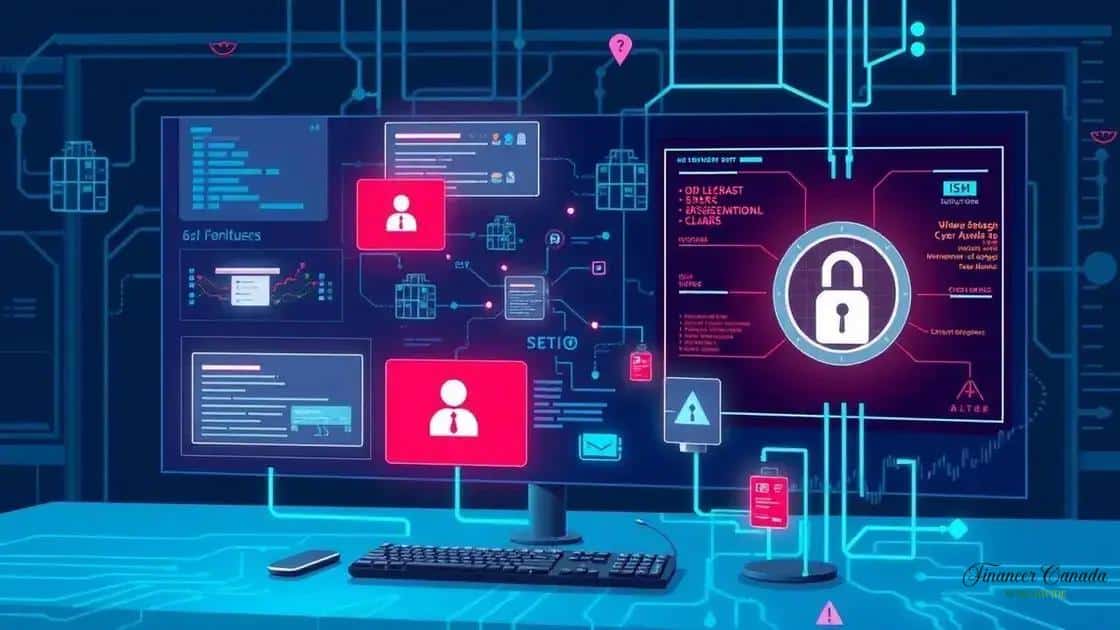Emerging cybersecurity threats in 2025: what to expect

Emerging cybersecurity threats in 2025 include advanced AI-enabled attacks, vulnerabilities in IoT devices, and a shift towards zero trust security models, necessitating enhanced detection and response strategies for organizations.
Emerging cybersecurity threats in 2025 are set to reshape how we approach online safety. With the digital landscape constantly evolving, you might wonder how these threats could affect your life and business. Let’s dive into what to expect.
Understanding the landscape of cybersecurity threats
Understanding the landscape of cybersecurity threats is essential in today’s increasingly digital world. With technology evolving rapidly, new vulnerabilities emerge constantly. This section will delve into the key aspects of the current threat landscape.
Types of Cybersecurity Threats
Cybersecurity threats can be categorized in various ways. The most common types include:
- Malware: This includes viruses, worms, and ransomware designed to disrupt or damage systems.
- Phishing: A technique where attackers deceive individuals into providing sensitive information.
- DDoS Attacks: Distributed Denial of Service attacks aim to overwhelm systems and make them unavailable.
As we consider the landscape, it is crucial to recognize that cyber threats are becoming more sophisticated. Criminals are now using artificial intelligence to innovate their attacks. This means that businesses and individuals must stay one step ahead.
The Role of Emerging Technologies
Technologies like the Internet of Things (IoT) introduce new vulnerabilities that challenge our security measures. Smart devices can be entry points for attackers if not properly secured. As devices connect to networks, they create potential risks that users should be aware of.
Moreover, the rise of 5G networks increases bandwidth and connectivity, allowing for faster data transmission. However, this can also attract more cybercriminals looking to exploit weaknesses in the new technology. It’s important for organizations to adapt their security protocols to address these changes.
Staying Informed
Keeping up with the latest trends in cyber threats is vital. Knowledge empowers you to make informed decisions. Regular training and awareness programs can help minimize risks. It is essential to foster a culture of security awareness, where everyone understands their role in protecting sensitive information.
In conclusion, the landscape of cybersecurity threats is ever-changing. By understanding the types of threats, the impact of emerging technologies, and the importance of staying informed, individuals and organizations can better protect themselves against future risks.
Key vulnerabilities to watch in 2025

As we look toward 2025, identifying the key vulnerabilities in cybersecurity becomes crucial for individuals and organizations. Awareness of these vulnerabilities can help mitigate risks and enhance security measures.
Common Vulnerabilities
Several vulnerabilities are expected to be major concerns in the coming years:
- Outdated Software: Many users fail to keep software updated, making systems prone to attacks.
- Weak Passwords: Poor password management continues to be a significant vulnerability, often leading to unauthorized access.
- Social Engineering: Attackers exploit human psychology to gain access to confidential information.
Among these, outdated software remains a prominent challenge. Attackers often target systems that haven’t received updates or patches, as they are easier to infiltrate. Similarly, weak passwords can be guessed or cracked, exposing sensitive data. With social engineering, cybercriminals cleverly manipulate users into revealing personal details, making awareness and education essential.
The Emerging Risks
The rise of the Internet of Things (IoT) also introduces new vulnerabilities. With more devices connecting to the internet, each device becomes a potential entry point for cyber attacks. Ensuring that IoT devices are secured is vital in safeguarding overall system integrity. Additionally, the adoption of cloud services continues to expand, which necessitates a focus on securing cloud environments against unauthorized access.
In an evolving landscape, the nature of cyber threats will change, requiring vigilant monitoring of vulnerabilities and proactive defenses. Organizations must invest in ongoing training and security protocols to address emerging risks effectively. Regular assessments and audits can identify gaps in security, allowing teams to respond to the evolving threat landscape.
How organizations can prepare for these threats
To effectively combat emerging cybersecurity threats, organizations must take proactive measures to prepare and protect their assets. Understanding these measures can significantly reduce risks associated with cyber attacks.
Implementing Comprehensive Security Policies
Creating robust security policies is the foundation for any organization’s defense strategy. Key elements to consider include:
- Access Control: Limit access to sensitive information and systems based on user roles.
- Regular Updates: Ensure that all software and systems are kept up to date to protect against vulnerabilities.
- Incident Response Plans: Develop and practice plans to respond to potential security breaches effectively.
Moreover, having a clear policy helps employees understand their responsibilities and the importance of maintaining security.
Training and Awareness Programs
One of the most effective defenses against cyber threats is educating staff. Regular training sessions can enhance awareness about phishing, social engineering, and other attack vectors. Employees should learn how to recognize suspicious emails and understand the protocols for reporting potential threats. Furthermore, incorporating hands-on simulations can reinforce the knowledge gained in training sessions.
As cyber threats continue to evolve, continuous learning becomes essential. By fostering a culture of security within the organization, teams are better equipped to respond to incidents swiftly.
Investing in Technology and Tools
Organizations should also invest in advanced cybersecurity tools. Firewalls, antivirus software, and intrusion detection systems play a pivotal role in protecting against cyber threats. Additionally, considering options like multifactor authentication enhances login security, making it harder for attackers to gain unauthorized access.
Incorporating artificial intelligence into security measures can help identify and mitigate threats in real-time, further safeguarding sensitive data. The combination of technology, policies, and training generates a comprehensive defense against emerging threats.
The role of AI in combating cyber threats

The role of AI in combating cyber threats has become increasingly important as technology advances. AI technologies can analyze vast amounts of data and detect anomalies that signify potential threats. This capability allows organizations to respond more quickly and effectively to cyber attacks.
Detection of Cyber Threats
AI can enhance the detection of cyber threats in several ways. By using machine learning algorithms, AI systems can:
- Identify Patterns: AI tools can learn from previous attacks and recognize patterns that may indicate future threats.
- Analyze Data: AI can sift through and process massive datasets faster than human analysts, increasing the likelihood of spotting threats early.
- Respond in Real-Time: With automated response capabilities, AI can take immediate actions to neutralize threats before they escalate.
This proactive approach is essential in today’s fast-paced digital environment where threats evolve rapidly. Regular updates to the AI models ensure they stay relevant to emerging threats.
Automating Threat Responses
Another key aspect of AI in cybersecurity is the automation of threat responses. Automated systems can react to threats based on predefined protocols, reducing the time it takes to mitigate risks. For instance, if an AI detects unusual network activity, it can automatically isolate affected systems to prevent further damage.
Moreover, AI-driven security solutions continuously learn and adapt from new threats, which improves their effectiveness over time. This means organizations can better allocate their human resources to more complex security tasks while AI handles routine monitoring and response functions.
Enhancing Cybersecurity Frameworks
Integrating AI into existing cybersecurity frameworks can significantly enhance overall security postures. Organizations can leverage AI to implement advanced security measures, such as:
- Fraud Detection: Using AI to assess transaction behaviors and flag anomalies for further investigation.
- Vulnerability Management: AI can analyze systems for weaknesses and provide recommendations for remediation.
- Threat Intelligence: AI systems can gather relevant threat information from various sources, enabling organizations to adapt their strategies accordingly.
By combining human insight with AI capabilities, organizations can create a more robust defense against cyber threats that continue to challenge their security efforts.
Future trends in cybersecurity technology
Future trends in cybersecurity technology are evolving rapidly as new threats emerge. Understanding these trends helps organizations stay ahead of cybercriminals and protect sensitive data.
Increased Use of AI and Machine Learning
Artificial intelligence (AI) and machine learning will play a crucial role in shaping the future of cybersecurity. These technologies will allow for:
- Automated Threat Detection: AI can quickly identify unusual patterns and flag potential threats without human intervention.
- Behavioral Analytics: AI tools can monitor user behavior to detect anomalies that may indicate compromised accounts.
- Predictive Security: Machine learning can use historical data to predict future cyber threats, enabling organizations to take preventative measures.
As advanced algorithms become more sophisticated, organizations will benefit from enhanced protection with minimal manual effort.
Zero Trust Security Models
The zero trust security model is gaining popularity as organizations aim to strengthen their defenses. This approach assumes that threats can exist both inside and outside the network. Key components include:
- Continuous Verification: Users and devices must be continuously authenticated, minimizing the risk of unauthorized access.
- Segmented Networks: Limiting access to sensitive data reduces exposure and potential damage from attacks.
- Least Privilege Access: Users are given only the minimum level of access required to perform their duties.
This strategy not only enhances security but also helps organizations respond to breaches more effectively.
Cloud Security Innovations
As more businesses migrate to the cloud, innovations in cloud security will be essential. Future trends may include:
- Improved Encryption: Enhanced encryption methods will safeguard data both in transit and at rest.
- Cloud Security Posture Management (CSPM): Automated tools will help identify and remediate risks in cloud configurations.
- Data Loss Prevention (DLP): Advanced DLP solutions will prevent sensitive data from being shared inappropriately.
These innovations will provide organizations with the tools needed to secure their cloud environments effectively.
In summary, as the cybersecurity landscape evolves, organizations must keep pace with emerging technologies and strategies to stay protected against future threats.
FAQ – Frequently Asked Questions about Emerging Cybersecurity Threats
What are emerging cybersecurity threats?
Emerging cybersecurity threats refer to new and evolving tactics and techniques that cybercriminals use to exploit vulnerabilities in systems and networks.
How can AI help in combating cyber threats?
AI can automate threat detection, analyze vast amounts of data quickly, and help organizations predict potential cyber attacks based on historical patterns.
What is the zero trust security model?
The zero trust security model assumes that threats can exist both inside and outside the network, requiring continuous verification for all users and devices.
Why is employee training important in cybersecurity?
Employee training is critical as it educates staff on recognizing threats like phishing and social engineering, helping to prevent security breaches.





